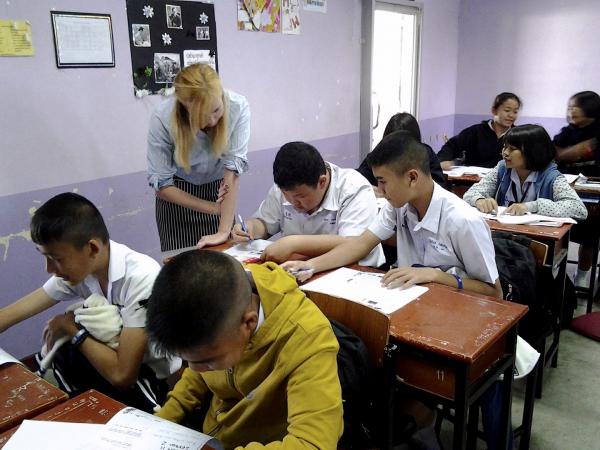For an American-trained teacher working overseas, little is more terrifying than walking into a classroom and feeling unprepared—especially when that classroom has an unprecedented number of students in it!
Whether the technology is not what you expected; student English language levels are lower than you anticipated; or you just got pulled in to cover a class for another teacher, having back-up lessons can be a lifesaver.
Teaching in Thailand and being the one who moves from classroom to classroom, I have learned the value of having certain portable go-to materials on all the time, things that I can quickly turn into a lesson anytime, anywhere, without the assistance of technology.
Here are my (quintessential) on-the-move teaching materials for TEFL teachers:
1. Balls
In my backpack in Thailand, I always have two small, soft balls with me.
On a typical day, I use these for a class warm-up, writing a question on the board and having students make a circle, answering the question as they toss and catch the ball to one another.
These balls can also be used for speaking games like "Hot Potato" or for reviewing vocabulary and accruing points by tossing the balls at a makeshift hoop, or target. Two gives me the added bonus of being able to separate students into two teams for such games.
2. A deck of cards
Both UNO and standard Bicycle playing cards have been used countless times in my EFL classroom.
For beginner English language learners, UNO serves as an opportunity to teacher or review colours and numbers. If you do have students play the game, they can practice saying the colour and number of the card they put down out loud.
For an exit ticket, I have given students three UNO cards at random and have had them write out and speak the colours and numbers on each—random draws prevent copying! These cards can also be used to divide students in to groups, by colour or number.
Card games are ubiquitous across all cultures and encourage cross-cultural exchange.
Regular playing cards come in handy for the same reason, though promote a bit more versatility. Games that utilize repetitive phrases such as "Go Fish" have proved a hit among all levels of students, as the (friendly) nature of the game play encourages them to get involved. Since playing cards use higher numbers and incorporate face cards, they can also be used to build vocabulary. Cards incorporate a gaming factor whenever they are used, just assign a number to a particular word, phrase, activity, or whatever you can think of and all of a sudden students are having to use multiple modes of thinking at once.
Finally, card games are ubiquitous across all cultures and encourage cross-cultural exchange and provide the opportunity for students to demonstrate their knowledge as well as learn.
3. Blank Paper
Paper is the basis of all crafting activities. Students can write on paper, draw on it, fold it, colour it, throw it, cut it: the list goes on.
Something I love to do with my students to introduce new vocabulary is cut up paper into tiny squares and write a new word on each. Students can each get a word and then either have to translate or draw a picture of the word on the paper’s opposite sides. For speaking activities, most students feel more comfortable when they have something in front of them to refer to, even if it’s a single word.
In my classes, I’ve used paper to make cards, travel brochures, cootie catchers aka paper fortune tellers (another fantastic opportunity to practice colours and numbers), memory games, plans for a trip and mazes to practice directions.
There’s no end to what you can accomplish with some blank paper and a little creativity.
4. Sticky notes
I will admit, I am a Post-It note fan. I don’t go anywhere without a stack stashed away in whatever bag I’m carrying.
Post-Its can function in the same way as pieces of blank paper, but with one added bonus: they’re sticky. This means that you and your students can stick Post-Its to the walls, to the doors, to the ceiling. Post-Its are great for labeling objects in the classroom to practice related vocabularly, as well as for games that get students to move around and stick their Post-It on a wall to vote or choose an answer.
This method is great for comprehension checks without the added stress of a formal quiz or test—and is a lot more fun, too!
There you have it, four of my favourite materials to carry-with me for emergencies and low-tech teaching. If you’ve used any of these in your classroom, comment below and let me know how it went!
Add this article to your reading list





